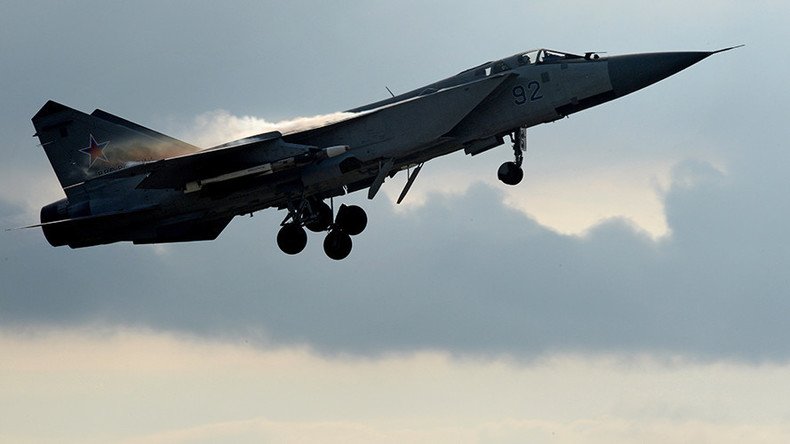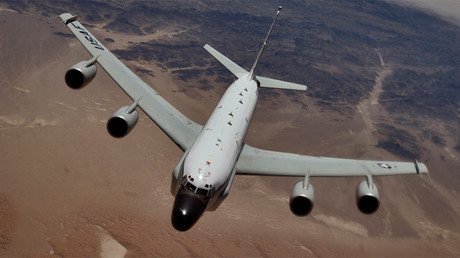World’s fastest jet MiG-31 intercepts US spy plane near Russia’s Far East

A Russian Air Force MiG-31 jet intercepted a US spy plane near Kamchatka in Russia’s Far East last week, flying within 15 meters of the aircraft. Washington downplayed the incident, saying it was carried out in a “safe and professional” manner.
The MiG-31 (NATO code name Foxhound) is a Soviet-design supersonic interceptor, the world’s fastest aircraft in service today. It got to within 15 meters of a US surveillance plane, which was flying in international airspace near the city of Petropavlovsk-Kamchatsky.
“On April 21, a US Navy P-8 Maritime Patrol reconnaissance aircraft flying a routine mission in international airspace was intercepted by a MiG-31 Russian jet in the vicinity of the Kamchatka Peninsula,” Cmdr. Dave Benham, a spokesman for the Pacific Command, told the Washington Free Beacon.
However, rather than kicking up a fuss, Benham added that the maneuver was carried out in a “safe and professional” manner.
“Intercepts between the United States and other militaries occur often and the vast majority are professional,” he said, speaking to the publication. “For intercepts that are deemed unprofessional, the US takes appropriate measures through military and diplomatic channels.”
The chairman of the Joint Chiefs of Staff, Maj. Gen. Joseph Dunford, said he has contacted his Russian counterpart Gen. Valery Gerasimov, the chief of the General Staff of the Armed Forces of Russia three times to warn against possible provocations.
Dunford and Gerasimov had both agreed not to go into details regarding the incident, but Dunford added that the interceptions pose "a risk of miscalculation arguably greater than it was in the Cold War,” the online publication Military stated.
Petropavlovsk-Kamchatsky is a sensitive area for Russia as it hosts one of the country’s most important naval bases, which is home to a large portion of Russia’s Pacific Fleet.
The base also contains the majority of Russia’s missile carrying nuclear submarines, sited on the Pacific coast.
On April 14, a Russian jet intercepted a US reconnaissance plane in the Baltic Sea. Danny Hernandez, a spokesman for European Command said a Russian Su-27 "performed erratic and aggressive maneuvers," only 50 feet (15 meters) away from the US aircraft.
The US Boeing RC-135 aircraft was "intercepted by a Russian SU-27 in an unsafe and unprofessional manner," Hernandez said, according to AFP, stressing that the US jet never entered Russian airspace.
The Russian Defense Ministry denied the accusations, saying the Pentagon’s assessment was inaccurate.
“On April 14, air defense forces detected over the Baltic ocean an unidentified aerial target rapidity approaching the Russian border. A Su-27 fighter jet was deployed by the Baltic Fleet to identify the target,” ministry spokesman Maj. Gen. Igor Konashenkov said after the incident.
“The flight of the Russian plane was in accordance with international standards for the use of airspace. No emergency situation occurred.”
The incident happened on the days before a Russian SU-24 and a Ka-27 Helix helicopter flew over the USS Donald Cook, a Navy destroyer that was conducting exercises with its NATO ally Poland in the Baltic Sea. The US called the encounter “aggressive flight maneuvers ...within close proximity of the ship.”
US Secretary of State John Kerry dubbed the behavior of the Su-24 pilots as “reckless” and “provocative,” saying that the US had every right to shoot the plane down.
The Russian Defense Ministry said the plane was flying over neutral waters and all the international regulations on the use of the neutral airspace had been met.
“While in operational proximity to the Russian naval base of the Baltic Fleet, the principle of freedom of navigation of the US destroyer does not negate the principle of freedom of aeronautics of Russian aircraft,” Russian Defense Ministry spokesman Konashenkov said.













